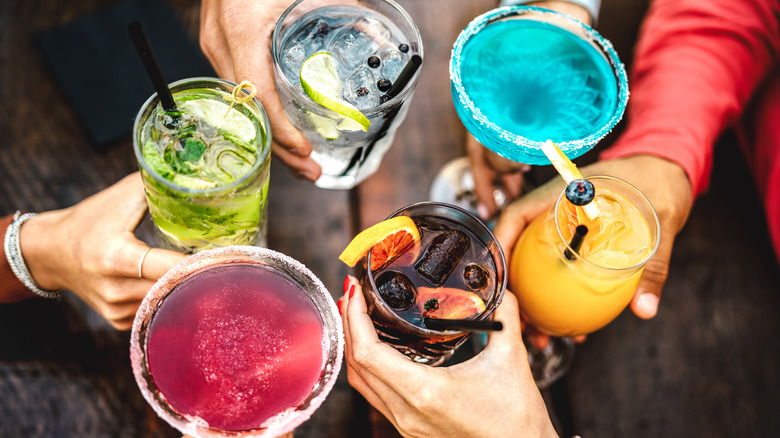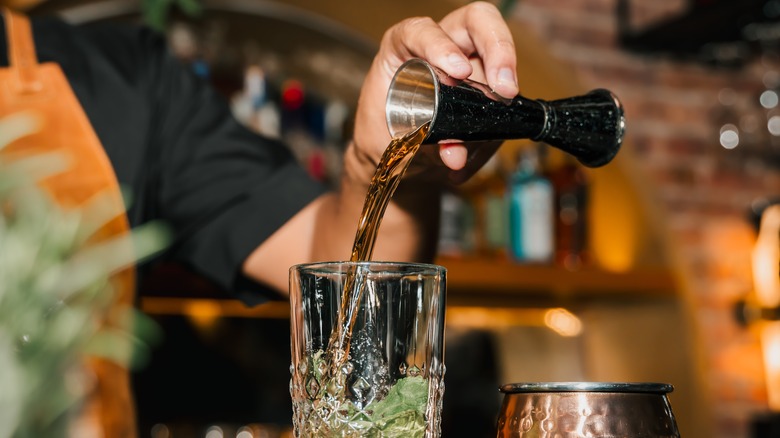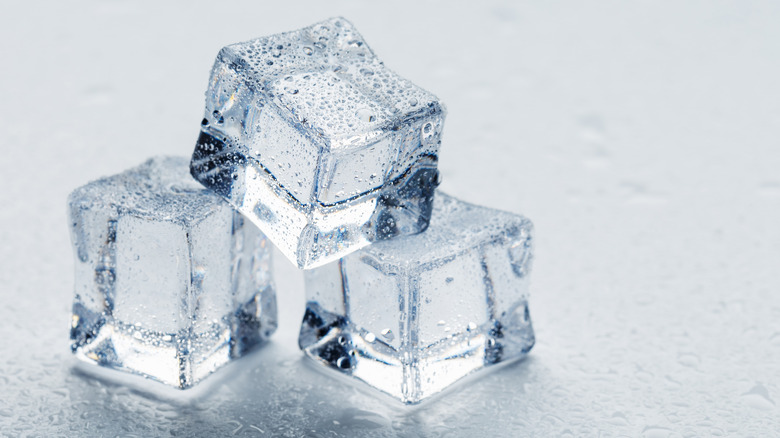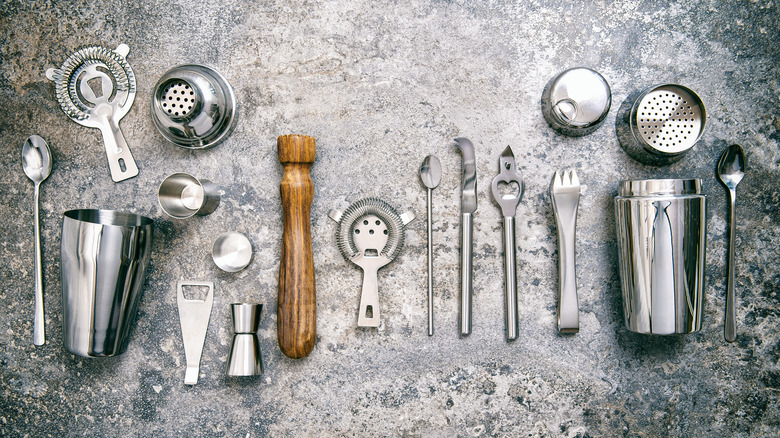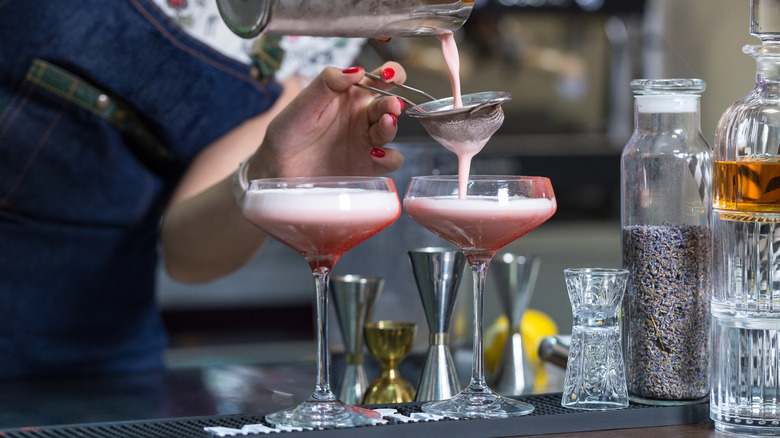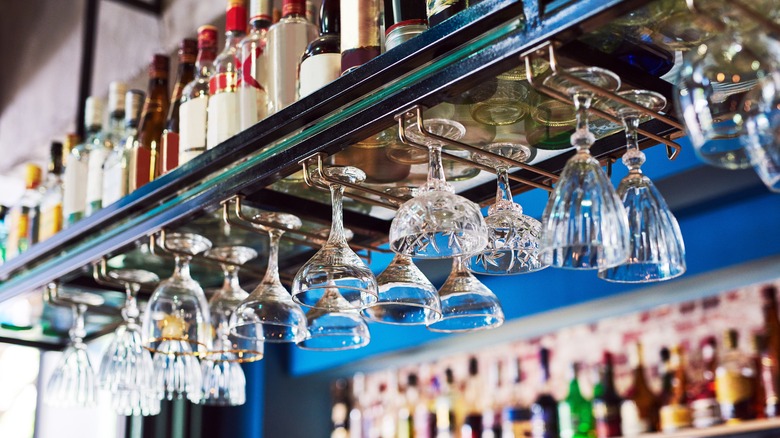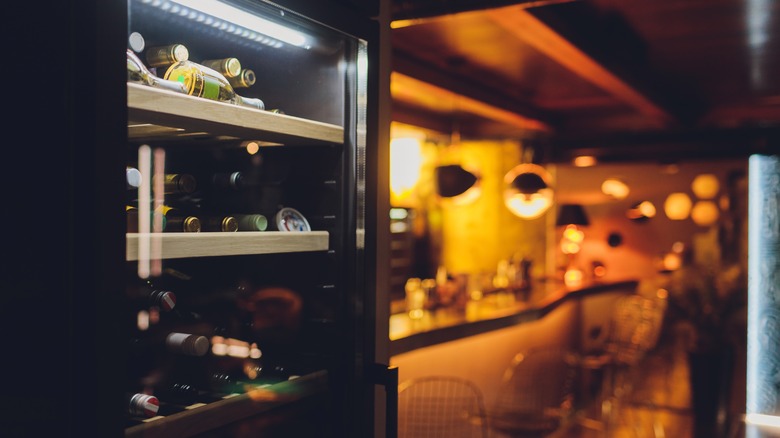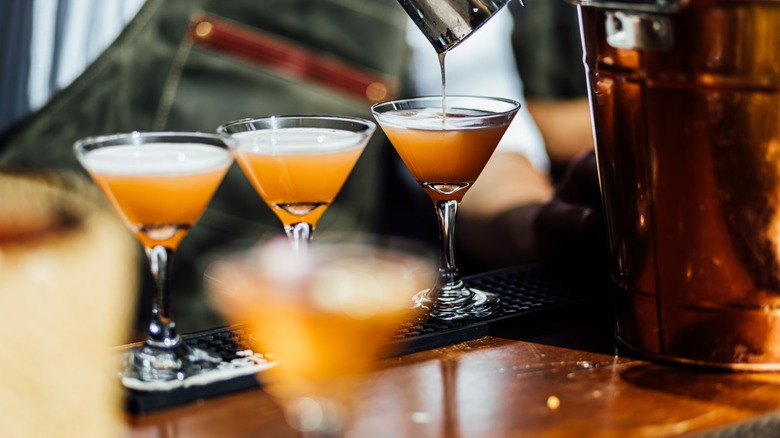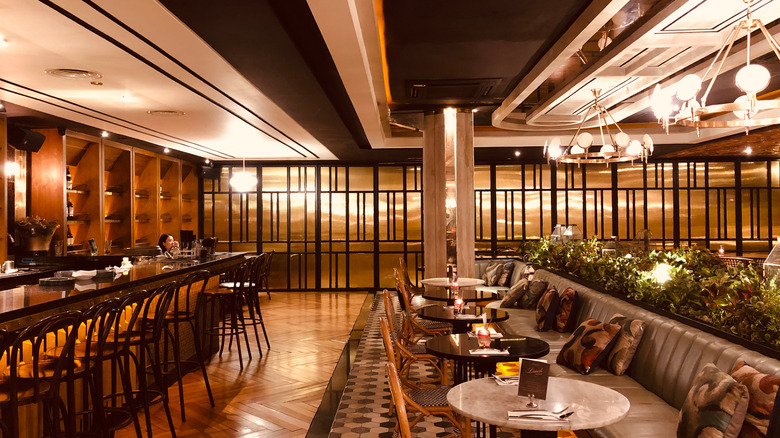Why Cocktails Always Taste Better From A Bar Vs At Home
Have you ever tried to recreate a favorite bar drink at home, only for it to come up short? For cocktail enthusiasts, this can be a frustrating experience. Even if you have the exact recipe and follow it to the letter, a cocktail made at home never seems to have the same pizzazz as one that's made for you by a professional. It's not some mystical alchemy or grand mystery — there are many factors that go into making cocktails, and both major and subtle differences that cause the gap between those made at home and those made in a bar or restaurant setting.
After spending two decades behind a bar as a mixologist, cocktail creator, and beverage manager, I've seen firsthand what makes a drink go from good to great. While you may never be able to reach the heights of quality that a professional bartender can achieve, having an understanding of these factors can help to elevate your home cocktail experience — and perhaps make you better appreciate the delicious drinks you get to enjoy when you're out and about. Read on to find out many of the reasons why those cocktails hit different.
Bars boast a vast selection of liquor
There are some amazingly impressive home bars out there, but even if you're a serious spirits collector, it's hard to build the same selection that the average bar has on hand. A bartender needs to be able to make as many drinks as possible to accommodate as many customers as they can, so it's important that they have access to all of the ingredients they need to craft a wide variety of cocktails. Selecting, sourcing, and stocking spirits and liquors for a bar takes a lot of work and is usually a full-time job. Of course, unless you're entertaining crowds every evening, you won't burn through bottles at home as quickly as a bar will. But it still takes dedication and time to keep a home bar fully stocked, and most people probably won't want to bother.
Bars also have access to unique, special, and rare bottles that are much tougher to track down if you're a retail consumer. When a particular item's demand outstrips supply, a distributor may allocate the few bottles they have to certain clients, often prioritizing bars and restaurants that they do the most business with. This can make hard-to-find bottles even harder to grab for your home bar, and can push their retail prices up considerably even if you are able to track them down (fans of whiskeys such as Pappy van Winkle know this all too well).
Cocktail recipes are precisely honed
Before a drink makes its way onto a bar's cocktail list, it likely goes through dozens of iterations, if not more — sometimes many, many more. Mixologists may work on their drink recipes for weeks, months, even years, always adjusting and tweaking them for ideal balance and flavor. The difference between a 1/2-ounce and a 1/4-ounce of one ingredient can totally change an entire drink, so cocktail creators will typically try as many combinations and ratios as they can before settling on a final recipe.
If you're working on creating your own drink recipes at home, you probably don't have the time to do that much research and development. And you may not want to make a dozen versions of the same drink just to test out slightly different variations. Thus, your home drinks may not be as polished and precise as those that have been crafted from inception to execution by a professional.
Even when it comes to classic recipes, which are more-or-less set in stone, a bar may slightly revise the ingredients or ratios to fit their needs. The traditional negroni cocktail, for example, is famously equal parts gin, Campari, and sweet vermouth. But if a bar's house gin is high proof and comes across as too hot, they may nudge the amount down and ratchet the other two ingredients up. These kinds of subtle changes come from a level of know-how and skill that's hard to reach outside of a professional setting.
Better ice makes a difference
This is a big one that many home bartenders overlook –- ice. In the olden pre-refrigeration days when ice was hard to come by except in winter, or if you lived in a tundra, cocktails as we know them didn't exist. Ice is much more than just a chiller and diluter; it's an integral part of every cold drink a bartender makes. If you're making cocktails at home, you may only have access to basic standard ice cubes from a tray, while a bar typically has a large selection of different sizes and types that can really help elevate their cocktails.
Some ice is better for shaking, some for stirring, and some for serving, and different types of drinks are best with certain sizes, shapes, and styles of ice. For example, many tiki-style drinks specify crushed or shaved ice, which offers lots of fast dilution to mellow out their particularly strong and potent ingredients. The classic Kentucky Derby staple, the mint julep, also calls for crushed ice — this keeps it nice and frosty on a hot day, and waters it down so you can keep going into the evening. Large cubes or spheres will dilute a drink quite slowly, which is ideal if you're planning on sipping at a leisurely pace. Many bars use high-quality mechanical ice creation systems, and some elite cocktail bars even hand-carve their own ice from large blocks, neither of which is feasible at home.
Juices and syrups are fresh and handmade
Making your own syrups for cocktails is a fun and rewarding activity if you're an enthusiastic home bartender. The problem is, unless you go through these ingredients rapidly or have a ton of refrigerator space, it's hard to keep the same wide selection of flavors and types of syrups that a cocktail bar boasts, and to make sure they're fresh. A well-provisioned bar will have both regular and rich simple syrup, cocktail staples like orgeat and grenadine, and other flavored syrups for their signature drinks. At home, even if you make cocktails a lot, you'll likely only use a few ounces of these syrups a week, and you run the risk of spoilage even if they're properly refrigerated. No one wants to put in that amount of work for items that are likely to go moldy and bad.
With fruit juices, you run into the same problem. Freshly-squeezed citrus juice is a must for quality cocktails, as they lose their vibrant flavor and zippy acidity quickly — many better bars will squeeze their lime and lemon, and often their orange and grapefruit juices, every day to ensure they're as fresh as possible. Some small, lower-volume bars can even squeeze their citrus to order for every individual drink. If you find that the citrusy drinks you make at home taste somewhat flat or dull, it's likely that your citrus juice isn't fresh enough.
High-quality bartending equipment is key
If you're a serious home mixologist, you've likely invested in high-end shakers, strainers, and other necessities for your bar. The quality of these items really does make a difference. Chintzy shakers can easily dent and warp, and may not seal together properly, making it harder to get a good, solid shake, and even causing disaster and injury if they separate while you're shaking. A bar spoon that's not properly weighted can make it nearly impossible to consistently dilute your stirred drinks. Bad quality mixing glasses are more likely to chip or crack, which can mean you may get shards of glass in your drink, a bartender's worst nightmare.
A good bar will not just have quality basic equipment, such as shakers and strainers, but also specialty items like swizzle sticks and muddlers that aren't necessarily home bar staples. It can take half a dozen separate tools to properly craft a cocktail, even one that's not particularly complex. To make individual ingredients and garnishes, even more equipment is needed: a dehydrator for dried citrus wheels, a blender for purees, a whipped cream canister for foam as just a few examples. To have such a well-equipped bar at home would cost hundreds of dollars even before you spend a penny on any actual alcohol, which means most home bartenders don't have access to many of these essential and premium tools. That lack is going to make the quality of the drinks suffer.
Repetition breeds perfection
If you've ever worked behind a bar, you know the aches and pains that crop up after a busy Friday night. Perhaps your hand is numb from muddling multiple mojitos, or your shoulders and biceps are sore from dry-shaking dozens of Pisco sours. Bartending, like any other skill, takes practice and a lot of hard work to perfect, and professional bartenders get plenty of opportunities to hone that skill by making drink after drink, night after night. In the same way that a restaurant cook on the line learns to make a dish consistently hundreds or even thousands of times, a bartender learns the ins and outs of making every drink through repetition. The goal of a bar's cocktail program is to achieve consistency and precision, which means every drink that goes out hits the same level of high quality, so it's essential that a bartender learns to make each drink so well that the process becomes second-nature.
This experience is virtually impossible to replicate without throwing yourself behind a busy bar and working the grind. A bartender picks up countless tips and tricks that they take with them after each shift, learning from colleagues and mentors, and constantly improving their knowledge and performance. Cocktail culture is always growing and evolving, too, and a good bartender is tuned into the breakthroughs and trends and always learning. These intangible qualities heighten every drink a professional bartender makes.
Proper glassware is selected for each cocktail
Depending on the type of bar you're in, the scope of the glassware selection on hand will vary. But even the diviest of dive bars will have multiple styles of vessels for different drinks. At minimum, you need a tumbler for drinks on the rocks like the standard old fashioned, a highball glass for mixer-heavy drinks like gin and tonics, and a cocktail glass for drinks served up like martinis and Manhattans. A serious cocktail bar will have multiple versions of each of these styles, in different sizes and dimensions, as well as other specialty glasses like hurricanes and copper mule mugs. This allows the bartender to pair each drink with a glass that complements it perfectly.
You may be skeptical about how much a glass can affect the drink — after all, isn't it what's inside the glass that matters? To an extent that's true, but you might be surprised by how much other factors can change your perception of flavor and quality. As an extreme example, try drinking the same cocktail out of a plastic cup and a crystal glass. The crystal vessel will better regulate the drink's temperature, add no off-flavors, and give the drink an air of sophistication and weight in your hand. Every glass should be the right size for the cocktail, too, so the glass is not too cramped or too empty, making it easier to enjoy the aromas and lessening the chance of spills.
Ingredients are properly stored
Are you keeping that opened bottle of vermouth sitting out on top of your bar? That's a bartending no-no -– vermouth, like the wine that makes up its base, degrades quickly once it's exposed to oxygen and left at room temperature. That's why any decent bar will store it in the fridge. But what about other bottles, like various liqueurs and syrups? Turns out there are a lot of bar products that will last longer and maintain their flavors better when refrigerated, especially if they're not going to be finished quickly after they're opened.
The lower a bottle is in alcohol by volume, the higher risk it has of deteriorating in quality. Alcohol serves as a preservative, so your overproof whiskeys or strong vodkas will be fine left on a shelf. But anything that's similar to wine in alcohol by volume — generally, around the 15% range — is best kept cold. This can include fruit liqueurs like schnapps, aperitifs like Aperol, and some Italian amaro liqueurs (which are also at home in the freezer), in addition to aromatized wines like vermouth. Non-alcoholic syrups should always be refrigerated to protect against spoilage. Knowing what items need to be stored where and at what temperature is key to ensuring your ingredients are always at their best, and bars typically have the systems and storage space to achieve this, with some even having multiple refrigerators kept at different temperatures to optimize each ingredient.
Collaboration elevates drinks
Some of the best cocktails you've ever had are almost certainly products of collaboration. A good bar team works on their drinks together, which means every drink that appears on the menu goes through layers of feedback and development long before the glass gets put in front of the customer. Bartenders tend to develop their own unique style when it comes to crafting cocktails, and this can sometimes lead to tunnel vision when crafting new recipes. Working with a team can help by bringing in new ideas, ingredients, and techniques that one person may not know about or consider.
The atmosphere of collaboration includes more than just the bar team. A discerning customer might try a drink and figure out what it needs to make it sing. Working at a bar means you're constantly in contact with people from all walks of life who possess all kinds of palates, and the steady feedback you get as a bartender from so many people is invaluable to the cocktail creation experience.
Bars that are attached to kitchens, like those that are parts of restaurants and hotels, have another level of collaboration that they can foster. The ability to use culinary ingredients in cocktails gives a mixologist almost endless possibilities when it comes to creative flavors. With both the kitchen and bar accessing the same ingredients, the cocktails are more likely to complement the dishes served there, elevating the customers' enjoyment of the drink even further.
Atmosphere and ambience add to the experience
The right combination of experience, ingredients, and equipment certainly elevate the quality of cocktails you get at a bar. But it's not just the drink itself that creates your impression. Every element of a bar is chosen for a reason, from seats to lighting to music. When you're ensconced in this carefully curated atmosphere, your drink may take on an aura of quality that it might not have at home.
The best bars will match the style of their offerings to the ambience of the space. If the bar's focus is high-proof, tropical party drinks, the atmosphere should be fun and festive — you probably won't want a string quartet in the corner playing quiet chamber music while you and your friends are sucking down a flaming scorpion bowl. On the flip side, an elegant, high-end martini bar probably shouldn't have flashing lights and raging punk music. Just as atmosphere and ambience can add to the drinking experience, the wrong combination can also detract. Even if the cocktail is perfectly made, your impression of it can be warped based on the environment around you.
Service also adds a key element to cocktail enjoyment at a bar. Even a mediocre beverage can seem like a masterpiece if your cocktail server or bartender is at the top of their game. An exceptionally skilled and friendly server can easily elevate any drinking experience — plus, drinking out means no work, and no dishes to do later.
